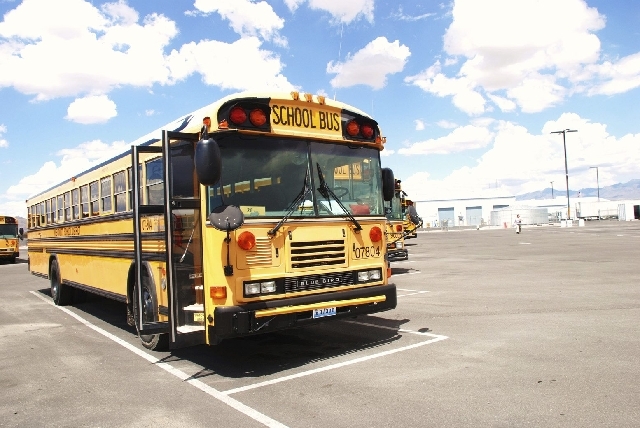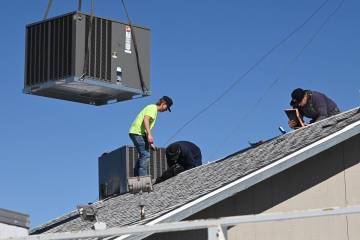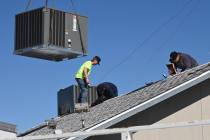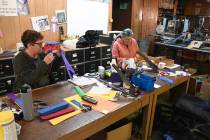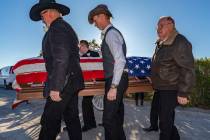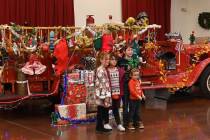NCSD bus drivers in it for the long haul
Busing students to school isn’t something most people think about, but the Nye County School District Transportation Department, its staff and drivers think about it every day of the school year, and just as often in the summer.
Nationwide, the majority of students from kindergarten to high school rely on the bus to get to school, and Nye County School District Transportation Manager Cameron McRae said, “That’s a very good thing.”
The buses get a workout. Aside from travel for athletics and other student activities, Nye County’s school buses travel an average of 4,509 miles every day transporting kids to and from area schools.
At 18,400 square miles, Nye is the largest county in Nevada. It also has the most rural routes numbering 87 daily. That’s 43 school buses traveling almost 5,000 miles a day, with drivers having two round-trip routes a day.
“It’s a big area and a big job,” said McRae, “and it’s complicated, but we have it organized to run as smoothly as it can be. A school bus is just a little yellow box with an environment for kids, but it is one of the most important things there is.”
An interesting development in the new school year for busing is there are less enrollees than in prior years and yet there is a 10 percent increase in students riding the bus. It’s a condition McRae describes as part of the downed economy and people driving less, thus using free options instead.
The transportation department, on the other hand, is operating with the same assets as when it had less riders. And the budget for 2013-14 includes kindergarten transportation this year, and additional trips for other reasons than in times past. Still, both the maintenance budget and the training budget remained stable.
McRae said because of added bus services for kindergarten and pre-kindergarten kids, more buses have joined the fleet. The district just bought seven new buses and they are in service.
“Every new bus costs about $141,000 each and their life span,” said McRae, “is somewhere between 23 and 25 years.” Just recently, the school board authorized retreads, or tires which are reworked, to replace rear tires. The cost is significantly less than new ones but McRae said the retreads are of high-quality. Front tires are always required to be new.
He noted the seven new buses do have air-conditioning and said those buses are used for away trips and for kindergarten and pre-kindergarten students.
None of the regular route buses have air conditioning and McRae said, “That can be challenging for everyone on regular route trips.”
A fact known by bus drivers but not by the general public is that the color yellow for school buses is standard internationally. It, like everything, is about safety. It was and is considered the easiest color to see at both dusk and dawn — especially as a contrast to the black lettering. Using yellow on school buses was adopted in 1930 by Congress, and there really is a paint named “School Bus Yellow.”
School start times have to be staggered in Nye County now that there is also an all-day kindergarten in Nevada. Starting at 6 a.m., buses begin to roll out from all locations to get students from middle and high schools to class on time. Drivers then return to a set stop and go out around 8 a.m. to get the kindergarten students and take them to school.
The routine is the same in the afternoon, and it’s a long day — especially for drivers going from Tonopah to Gabbs, Duckwater and Round Mountain among other distant locations.
By 2 p.m. buses are rolling again to pick up middle and high school students at the 2:10 p.m. dismissal time and have them home by 3 p.m. By 3:10 p.m. kindergarten students are on the bus and will be home by 4 p.m.
There are urban, suburban and rural routes. Here in Nye County a new designation for certain busing locations is Rural Remote.
Outside of Tonopah are two locations where a school bus goes to Gabbs School. Just as rugged and remote is Duckwater Reservation School for kindergarten through eighth grade.
The routes both have similar terrain with winter being the biggest challenge to driver, bus and riders.
There are 17 students attending the Duckwater Reservation School and 15 ride the bus to and from school. For them it means 100-plus miles a day, cellular phone coverage that is “not 100 percent,” and when it snows it can be a 90-minute drive, usually in the dark of morning and evening.
Duckwater high school aged students drive themselves and White Pine buses come to Lund to get students who go to school in that county.
Both Duckwater and Gabbs are 100-plus miles from Tonopah where mechanics for those schools, as well as the Tonopah area schools, will travel to deal with any maintenance or sudden mechanical issues.
Being rural remote locations means students and drivers face two mountain passes, a 50-mile drive to school and 50 miles back, steep grades and little foliage.
Students are picked up from ranches along the route, some close and some not so close to the only road. There is a state highway part of the way, then the county-maintained road is gravel and becomes a Bureau of Indian Affairs (BIA) road to the school which is also gravel.
Bad weather, according to Cameron McRae, could double the trip in travel time, as some ranches are three or four miles from the only road.
The driver decides if it’s a go or not, but if chains are required, it’s a no-go. These buses have the highest maintenance records, even though Gabbs students only attend four days per week.
The last bus driver for Gabbs ran the route for 30 years and just retired.
All bus drivers are required to have 40 hours of training total, at 10 different times during one year, which doesn’t include a summer workshop.
Drivers have to be devoted their schedules and their training. The week before school started this year they came to get route assignments. One driver noted she gets excited to get on the road again and meet the kids. “It’s not always easy, but it’s always interesting,” she said.
What are McRae’s short and long-range hopes for transportation this year?
He said, “I hope gas stays below $80 a barrel. The price affects all our oil and gas and tire issues.
“I hope our safety record stays intact and that we do what we’re trained to do: set a good tone for our riders to follow, and continue our good record of safety. We have very conscientious drivers.”
The district has had only one accident in its history with neither the bus nor the driver at fault.


